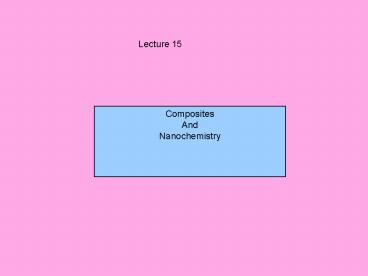Composites - PowerPoint PPT Presentation
1 / 33
Title:
Composites
Description:
Lecture 15 Composites And Nanochemistry Raman vibrational modes in SWNTs Raman vibrational modes in SWNTs * Nanomaterial reinforcement in composites Nanofibers in use ... – PowerPoint PPT presentation
Number of Views:163
Avg rating:3.0/5.0
Title: Composites
1
Lecture 15
Composites And Nanochemistry
2
Nanomaterial reinforcement in composites
3
Nanofibers in use
4
(No Transcript)
5
(No Transcript)
6
(No Transcript)
7
Nano-reinforced composites
Processing them into various matrices follow
earlier composite developments such
as - Polymer compounding - Producing filled
polymers - Assembly of laminate
composites - Polymerizing rigid rod
polymers Purpose - Replace existing
materials where properties can be
superior - Applications where traditionally
composites were not a candidate
8
Benefits of nanotech for composites
Nanotechnology provides new opportunities for
radical changes in composite functionality Maj
or benefit is to reach percolation threshold at
low volumes (lt 1) when mixing nanoparticles in
a host matrix Functionalities can be added
when we control the orientation of the
nanoscale reinforcement.
9
Multifunctionality in materials
This always implies structure since in most
cases the major function of a structure is to
carry load or provide shape. Additional
functions can be Actuation
controlling position, shape or
load Electrical either insulate or
conduct Thermal either insulate or
conduct Health monitor, control Stealth ma
naging electromagnetic or visible
signature Self-healing repair localized
damage Sensing physical, chemical variables
NRC Report, 2003
10
Multifunctional materials sensing
Building in additional functionalities into
load-bearing structures is one key
example - Sensing function Strain
Pressure Temperature Chemical
change Contaminant presence Miniaturized
sensors can be embedded in a distributed fashion
to add smartness or multifunctionality. This
approach is pre-nano era. Nanotechnology,
in contrast, is expected to help in assembling
materials with such functional capabilities
11
Examples of multifunctional materials
Possible, in principle, to design any number of
composites with multiple levels of functionality
(3, 4, 5) by using both multifunctional matrices
and multifunctional reinforcement additives
- Add a capsule into the matrix that contains
a nanomaterial sensitive to thermal,
mechanical, electrical stress when this breaks,
would indicate the area of damage - Another
capsule can contain a healant - Microcellular
structural foam in the matrix may be
radar-absorbing, conducting or
light-emitting - Photovoltaic military uniform
also containing Kevlar for protection generate
power during sunlight for charging the batteries
of various devices in the soldier-gear
NRC Report, 2003
12
Composite materials
Carbon nanotubes, nanofibers Polymer clay
nanocomposites Polymer cross-linked
aerogels Biomimetric hybrids Expectations -
Designer properties, programmable materials -
High strength, low weight - Low failure
rates - Reduced life cycle costs
13
A self-healing material
Self-healing plastic by Prof. Scott White (U.
of Illinois) Nature (Feb. 15, 2001) Plastic
components break because of mechanical or
thermal fatigue. Small cracks and large cracks
catastrophic failure. Self-healing is a way of
repairing these cracks without human intervention
. Self-healing plastics have small capsules
that release a healing agent when a crack forms.
The agent travels to the crack through
capillaries similar to blood flow to a
wound. Polymerization is initiated when the
agent comes into contact with a catalyst
embedded in the plastic. The chemical
reaction forms a polymer to repair the broken
edges of the plastic. New bond is complete in
an hour at room temperature.
14
Fine Particle Technology
Frequently encountered powders - Cement,
fertilizer, face powder, table salt, sugar,
detergents, coffee creamer, baking
soda Some products in which powder
incorporation is not obvious - Paint, tooth
paste, lipstick, mascara, chewing gum, magnetic
recording media, slick magazine covers, floor
coverings, automobile tires For most
applications, there is an optimum particle
size - Taste of peanut butter is affected by
particle size - Extremely fine amorphous silica
is added to control the ketchup flow - Medical
tablets dissolve in our system at a rate
controlled by particle size - Pigment size
controls the saturation and brilliance of
paints - Effectiveness of odor removers is
controlled by the surface area of adsorbents.
From Analytical methods in Fine Particle
Technology, Webb and Orr
15
Fine Particles 2
Adding certain inorganic clays to rubber
dramatically improves the lifetime and
wear-characteristics of tires. Why ? The
nanoscale clay particles bind to the ends of the
polymer molecules - which you can think of as
molecular strings - and prevent them from
unraveling.
16
Reactions of shaped carbons
Detection Reactions
17
The electron microscope
18
Electron Microscopy and tube wall measurements
19
Raman vibrational modes in SWNTs
ID/IG ratio
G
D
20
Chemistry
A. Hirsch, Angew. Chem. Int. Ed., 41 (2002) 1853.
21
The main approaches for the modification of these
quasi one-dimensional structures can be grouped
into three categories (a) the covalent
attachment of chemical groups through reactions
onto the ð-conjugated skeleton of CNT (b) the
noncovalent adsorption or wrapping of
various functional molecules and (c) the
endohedral filling of their inner empty cavity.
22
SWCNT chemistry
23
Chem Rev, 106 (2006) 1105
24
(No Transcript)
25
(No Transcript)
26
(No Transcript)
27
(No Transcript)
28
(No Transcript)
29
Functionalisation of CNTs Prato reagent
30
CNT-Polymer mixtures
31
Nanotubes different scale lengths
32
The Space Elevator
33
Application of f-CNTs in Medicine/Pharmacy
C. Klumpp et al. / Biochimica et Biophysica Acta
1758 (2006) 404 412
Confocal microscopy images of 3T6 cells incubated
with fluorescent CNT
f-CNT penetrated into the cells
Antifungal activity of AmB conjugated to carbon
nanotubes (CNT 2). Candida parapsilosis (black
bar) Candida Albicans (dashed bar) Cryptococcus
neoformans (grey bar).

